Interstellar Space Travel: 7 Futuristic Spacecraft to Explore the Cosmos
To the stars
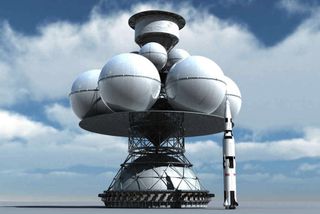
Astronomers recently announced strong evidence of an Earth-like alien planet around Proxima Centauri, the star closest to our sun, making it the closest exoplanet found to date. Though the star system is our cosmic neighbor, it is still located 4.2 light-years, or 25 trillion miles, away from Earth. At such distances, could we ever visit the newfound planet?
Even the nearest stars would takes tens of thousands of years to reach using conventional spacecraft, such as the robotic probes being used now to explore the solar system. These spacecraft are driven by a combination of chemical rockets, low-thrust ion drives and gravity-assisted trajectories — including so-called "slingshot maneuvers" around the sun or large planets that give them a big burst of speed.
But if we're going to travel beyond our solar system, we're going to need something a little faster than that — perhaps something like the giant Project Daedalus fusion rocket, shown here to scale with NASA’s Saturn V rocket in an illustration by graphical engineer and space artist Adrian Mann, whose work is featured in this countdown of futuristic space technologies. Here are seven ways that robots, or even human explorers, could visit the Proxima Centauri system or other cosmic neighborhoods.
Project Daedalus

Project Daedalus is a concept design for an interstellar probe, developed in the 1970s by a group of technical specialists for the British Interplanetary Society. The target destination was Barnard’s Star — a red dwarf about 6 light-years away, in many ways similar to Proxima Centauri, where astronomers now report they have found signs of a potentially habitable planet. When Project Daedalus was conceived, some astronomers thought a gas giant planet might be in orbit around Barnard's Star, but since then, no planets have been found in the star system.
The result of the five-year project was the design of the Daedalus spacecraft, a two-stage, 54,000-ton nuclear rocket that would boost a 400-ton robotic probe to around 12 percent of the speed of light. This would enable the probe to make the 6-light-year journey to Barnard’s Star in around 50 years.
The rockets of the Daedalus spacecraft would be powered by nuclear fusion, using electron beams to detonate a stream of pellets of fuel such as helium-3, which could be mined from the surface of the moon. Even so, the engines would consume tens of thousands of tons of fuel to get the spacecraft up to its top speed in about 4 years — and because there wouldn’t be any fuel left to slow down, the end result of the 50-year journey would be just a 70-hour flyby of the destination system, before the spacecraft speeds past into interstellar space.
The Daedalus would be much too large to lift off from the Earth’s surface, so it would have to be built in orbit, which means spacecraft like this couldn’t be built without a capacity for construction in space that doesn’t exist today, said space scientist Ian Crawford, a professor of planetary science and astrobiology at Birkbeck College in the United Kingdom.
While Crawford thinks the science behind the Project Daedalus concept is better understood now than when the spacecraft was designed, he said the immense cost and enormous technical challenges likely mean it would be more than 100 years before something like the Daedalus sets out for the stars.
Project Icarus

The Project Daedalus concepts from the 1970s are the inspiration for Project Icarus, an ongoing joint project by the British Interplanetary Society and the Icarus Interstellar organization, an international network of scientists, engineers and enthusiasts who hope to develop the capabilities for interstellar spaceflight by the year 2100.
Project Icarus is designed to reach any star within 22 light-years of Earth that has a potentially habitable exoplanet, meaning if a planet is confirmed around Proxima Centauri, it could become a target destination.
Project Icarus aims to update the Daedalus design with new technologies and ideas. Among the refinements proposed are fusion rocket engines that use a different nuclear fuel, which would be detonated by lasers instead of electron beams — a technology that could draw from recent advances in laser-ignition fusion at the National Ignition Facility at Lawrence Livermore National Laboratory in California, Crawford said.
The Icarus probe could also be smaller than the 400-ton probe envisioned for Project Daedalus, thanks to advances in electronic miniaturization and robotics, and future nanotechnologies — which would mean the spacecraft would need to carry less fuel to reach its full speed.
Light sail
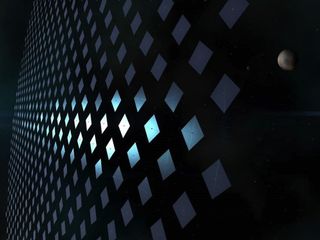
Our best bet for interstellar travel may be to not use a rocket at all, Crawford said. Light sails, which use the pressure of light to propel a payload, are already being considered for interplanetary space probes, and in 2010 Japan’s experimental IKAROS spacecraft successfully used its 60-foot-wide (20 meters) light sail to maneuver during a six-month journey to Venus.
But although light sails driven by sunlight are already an effective way to explore the solar system, they are not fast enough to cover interstellar distances in a reasonable amount of time.
Crawford said the answer may be to use powerful lasers to push the light sail to very high speeds with bursts of light at the start of the journey, until the spacecraft is too far from the laser source to gain more thrust from the light beam.
Since the driving lasers would be built on Earth or in orbit, interstellar light-sail spacecraft would not need to carry fuel for the journey, and so the mass of the spacecraft could be kept small.
Laser-driven light sail spacecraft are the basis of the Breakthrough Starshot project that was announced this year by investor Yuri Milner and physicist Stephen Hawking. The project aims to build a working prototype by 2036 at a final mission cost of around $10 billion dollars.
The project envisages a swarm of around 1,000 stamp-size "StarChip" spacecraft, each weighing a few grams and attached to a light sail measuring 13 feet (4 m) across, which would be deployed from a "mothership" in orbit before being accelerated by ground-based lasers to speeds of around 15 to 20 percent the speed of light.
This would allow the spacecraft to make the 4-light-year journey to the Alpha Centauri system — a triple-star system that includes the star Proxima Centauri and its possible planet — in between 20 and 30 years.
The concepts behind the Breakthrough Starshot project have been studied by Philip Lubin, a professor of cosmology at the University of California, Santa Barbara, who says the biggest challenge remaining is to create sufficiently powerful lasers to drive the light sail spacecraft.
Bussard ramjet
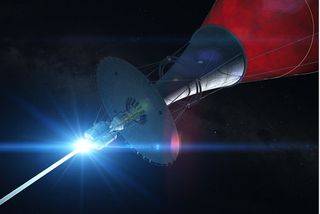
The Bussard Ramjet concept, proposed by physicist Robert Bussard in 1960, combines the high thrust of fusion rockets with the low fuel requirements of light sails.
Instead of carrying its own fuel, a Bussard Ramjet would scoop up the very thin traces of gas and dust found in interstellar space, known as the Interstellar Medium, using a vast funnel-shaped electromagnetic field that extends for thousands of miles in front of the spacecraft.
Hydrogen from the Interstellar Medium would then be compressed and used as fuel in a fusion rocket at the rear of the spacecraft that drives it forward.
In theory, a spacecraft driven by a Bussard Ramjet could continue to accelerate as long as there is enough interstellar gas in its path to provide enough thrust, and could reach a high fraction of the speed of light.
As a result, the venerable Bussard has seen long and honorable service in many works of science fiction, notably Larry Niven’s "Known Space" series of novels and short stories, including the "Ringworld" books; and the 1970 Poul Anderson novel "Tau-Zero" (Doubleday, 1970), in which an interstellar crew push their stricken Bussard spacecraft to relativistic speeds to avoid destruction.
Unfortunately, the Interstellar Medium around our solar system and the nearby stars is especially thin, and scientist have calculated that there’s just not enough hydrogen there to fuel a Bussard Ramjet. "It's not the ideal part of the galaxy," Crawford said.
But he explained that several ideas have been proposed to get around this limitation, including a concept known as a “Ram Augmented Stellar Rocket”, which uses collected matter as reaction mass to drive the spacecraft forward, using energy beamed to it by a laser; and an "Interstellar Runway," which would use deposits of fuel positioned in advance in the path of an accelerating Bussard spacecraft.
Antimatter rocket & black hole drive
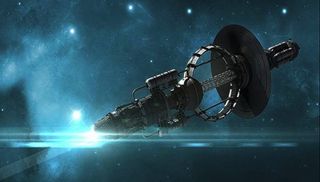
Beyond light sails, giant lasers and fusion rockets, a few even more exotic options for interstellar travel have been proposed, such as rockets powered by the extremely violent (and supremely efficient) annihilation reaction of matter and antimatter.
"Antimatter would be an excellent rocket fuel, because its energy density is so high," Crawford said. "But, of course it doesn't exist in nature, we have to make it. And it's very difficult and expensive to make, and very dangerous once you've made it — so who knows whether it could ever be used as a rocket fuel?"
Another proposal for using exotic physics to drive a spacecraft is the "Schwarzschild Kugelblitz" drive, which would use a microscopic, artificial black hole contained within its engines as its power source.
One idea for a ship equipped with the so-called "SK Drive," shown above, would trap Hawking radiation from the rapid and extremely violent decay of the tiny black hole, and convert it to energy that can be used it to propel the spacecraft.
Each of the artificial black holes would only survive for a few years, so new black holes would need to be created on demand, possibly by compressing pellets of matter with gamma-ray lasers.
According to a 2009 research paper, an SK-drive starship powered by a microscopic black hole with the mass of a modern supertanker could accelerate to 10 percent of the speed of light within 20 days. The black hole would last around 3.5 years before it decayed entirely, and would output more than 160 petawatts, or 160 quadrillion watts, of power in its lifetime.
Human "Slow Boats"
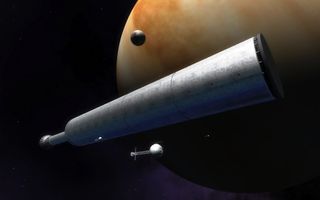
Even with super-fast rockets traveling at speeds of 10 percent or more of the speed of light, it would take many human lifetimes to reach all but the very nearest stars. And although Crawford is an advocate of human exploration of the solar system, he said that interstellar distances are too vast to make a human voyage conceivable within the next few hundred years.
"I think humans can explore the planets more effectively than robots, and I also think there are cultural reasons for sending humans into space, to broaden our range of experiences and enrich human culture," he said. "Now, it’s true that all of that would apply on the interstellar scale as well — it’s just that the distances are so large and the technical difficulties so great that advocating it at this stage is almost inconceivable."
Even so, several ideas exist for what are known as "Slow Boat" concepts that might one day take humans to the stars, including:
Sleeper Ships, in which human crewmembers are kept in a state of "deep sleep" or "suspended animation" for the duration of the very long voyage. This idea has featured in several science fiction movies, including Stanley Kubrick’s "2001: A Space Odyssey" made in 1969, Ridley Scott's "Alien" in 1979 and James Cameron's "Avatar" in 2009.
World Ships, also known as generation ships or interstellar arks, would be giant self-contained space habitats carrying large populations of humans and other species from Earth on a relatively leisurely journey to colonize exoplanets — journeys that would take many centuries to complete. Entire generations would live and die during the voyage, and only the descendants of the original population would arrive at the destination.
Embryo Ships would send cryogenically frozen embryonic humans, instead of sleeping or living humans, to a distant colony planet, where they would be "hatched out" and educated on their mission by a crew of protective robots.
Faster than light?

Wherever astronomers look in the universe, the Theory of Relativity holds fast. As Albert Einstein showed, it's not possible to accelerate a mass to the speed of light in space, nor past it.
But Einstein's equations may yet hold a few tricks that could someday let science do an end-run around the known laws of physics and achieve faster-than-light (FTL) travel — a Holy Grail for generations of science fiction fans.
The best known scientific concept for FTL travel is the Alcubierre drive, proposed by theoretical physicist Miguel Alcubierre in 1994.
The proposed drive operates by using intense gravitational forces, generated by two rotating rings of dense exotic matter, to shrink the physical dimensions of space in front of the spacecraft while expanding the space behind it, at a rate that could appear to exceed the speed of light.
In Alcubierre's proposal, which requires a type of exotic matter for the rings that is not known to exist, the spacecraft inside the "warp bubble" created by the drive would never travel faster than light in its local space, and so would not violate the laws of relativity.
Other speculative ideas for FTL travel include using trans-dimensional wormholes — also theoretically possible, but not known to exist — to travel between entangled but distant regions of space; or to daringly skim the edges of a large, spinning black hole, as depicted in Christopher Nolan’s 2014 movie "Interstellar."
But Crawford notes that the concept of faster-than-light travel is rife with unknowns and apparent contradictions, such as violating the principle of causality, in which events are caused by other events that happened earlier in time, and not the other way around. So, it's likely the proposals would prove impossible, even if they were technologically feasible to attempt.
"I don't want to sound overly pessimistic, because I can see huge benefits of being able to travel to the stars, but the laws of physics are the laws of physics, and it is going to be really difficult," Crawford said.
Sign up for the Live Science daily newsletter now
Get the world’s most fascinating discoveries delivered straight to your inbox.
Tom Metcalfe is a freelance journalist and regular Live Science contributor who is based in London in the United Kingdom. Tom writes mainly about science, space, archaeology, the Earth and the oceans. He has also written for the BBC, NBC News, National Geographic, Scientific American, Air & Space, and many others.
